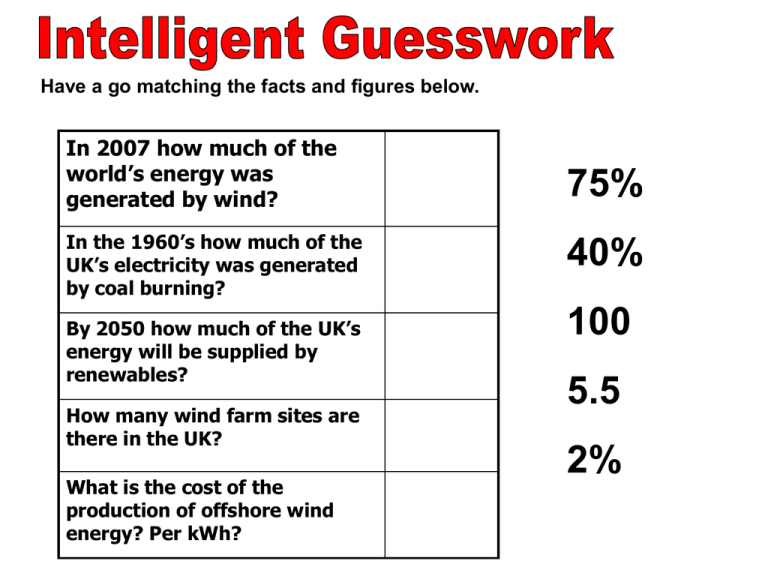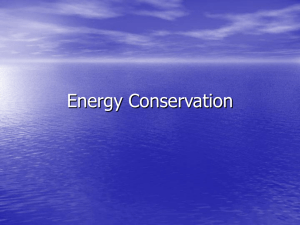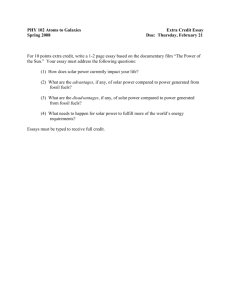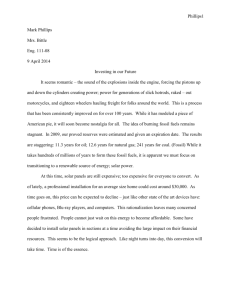File
advertisement

Have a go matching the facts and figures below. In 2007 how much of the world’s energy was generated by wind? In the 1960’s how much of the UK’s electricity was generated by coal burning? By 2050 how much of the UK’s energy will be supplied by renewables? How many wind farm sites are there in the UK? What is the cost of the production of offshore wind energy? Per kWh? 75% 40% 100 5.5 2% What is a resource? Key ideas: • A resource is anything – natural or man-made – which humans can use. • All industries need resources in order to operate. • Most resources come originally from the Earth, for example iron ore, copper, coal, oil and lead. A farmer will consider the land itself as a resource, and for a modern industry the skill of its workers is its most important resource. What is a resource? • A resource is anything that can be used by humans for a purpose. Resources are constantly changing in importance e.g Uranium was not a resource until the invention of Nuclear power. Resources can be classified as: - Renewable – Resources that can be used again and again and will not run out in the foreseeable future e.g the wind, wave power or the sun. - Non-renewable – Resources which can only be used once and which have a finite supply i.e. they will run out. • People use resources every day to improve their lives and standard of living. In general terms, HIC’s use more resources than LIC’s although this does not mean that they have more resources to begin with. Resources are distributed across the world by trade. This is dependent on how rich you are. USA has 6% of the world’s population but uses 36% of the world’s resources Classification of resources Resources Natural (physical) resources Human and economic resources • • • • Non-renewable people skills machinery capital Renewable Fossil fuels Minerals • oil • iron ore Continuous • wind • waves Sustainable • • • • • forests soils water ecosystems landscapes Why is the world demand for resources increasing? The demand for, and use of, the world’s resources continues to grow at an increasingly faster rate. This is mainly due to the three following factors. Factor What is happening? Population Growth Total world population: • 1980 = 4.4 billion • 2005 = 6.4 billion • 2015 (est) = > 7 billion Increasing Wealth Technological Advances Many MEDCs have had stable populations for the last 30 years but energy used per person has increased. The richer a country gets, the more energy it uses. New products are continually being invented and new resources constantly being developed. Explanation of why this increases the demand for resources A growing population needs food and water. The more people there are, the more resources we need. The more we have the more we seem to want. Lets take one example, the invention of the car. This alone has contributed to the increased use of oil. 1. 1990’s – historically Britain has always generated the majority of its electricity from burning coal. In 1960 75% of Britain’s power was generated from burning coal. 2. As Britain continued to industrialise and develop its energy demands grew. Britain began to use a combination of fossil fuels – oil, gas and coal! 3. The UK’s economy is reliant on a efficient energy system. We need electricity to power factories, heat and light homes and for computers and office machines. 4. Scientists have known for a long time that fossil fuels are a finite resource and in recent times we have started to witness ‘a dash for gas’ as resources are becoming depleted. 5. On top of this the burning of fossil fuels has been linked to atmospheric pollution and is a major contributor to climate change. 6. For a while now the government has realised that a sustainable solution is needed to the UK’s pending energy crisis. 7. A long term natural renewable resource is the only solution. This could include harnessing wind, solar or tidal power to generate electricity. 8. As the UK is windiest country in Europe. Harnessing wind energy by building wind farms seems the best solution. 9. The UK government favour wind energy as the best option for hitting their 20% by 2020 target. So is encouraging energy firms to invest in wind farms and put pressure on local authorities to grant planning permission. 10. There are stacks of benefits to wind energy including wind is a renewable resource, it doesn’t cause air pollution, jobs would be created, could meet 30% of Britain’s electricity needs by 2040. 11. Most recently a proposal was put forward to build a wind farm on the isle of Lewis in the Outer Hebrides. 12. The proposal was rejected for several reasons the ecology and environmental damage the turbines could cause to the local peatland ecosystems. The 11,000 population of the Isle of Lewis are pleased with the outcome. Saved by the wind? Our use of fossil fuels is not sustainable. They are linked with global warming – and they’ll run out one day. Now the pressure is on to get less electricity from fossil fuels such as coal, oil and gas, and more from renewable sources of energy such as wind power. Renewable sources wont add to global warming. Availability of resources • ANSWERS Term Definition Example Non renewable Can be renewed by Wood humans and therefore will last Sustainable resources Can’t be remade, Wave being used up, once gone they are gone Renewable, sustainable resources These renew themselves and don’t need managing Diamonds 1 Solar Energy There are 3 types : • Thermal solar energy (black water-filled tanks which absorb the sun’s heat and turns cold water into warm/hot water. Reasonably cheap to produce. • PVC – Photo-voltaic cells (like the ones on your calculator) which convert sunlight directly into a small electric charge. Fairly expensive to produce but the cost is coming down • Reflective solar energy : redirecting and focusing the sun’s rays onto a central point to boil water to steam, which then turns a turbine to make electricity Needs : •High % of cloudless skies •High angle of sun in the sky (not high latitudes) •Low rainfall region Massive solar array at Seville in S. Spain – Europe’s first commercial solar power plant of its type. Limitations : Potential : • No energy is produced at night • Significant potential in high sunshine areas (California, S. Europe, much of Africa.) as a ‘supplement’ to energy use • less energy is produced in winter – when demand is higher • energy can’t be ‘stored’ easily – needs to be used as it is produced • countries in high latitudes (so having cold winters) have little solar potential. • Can be used on a small scale for such things as refrigerators to keep anti-malaria drugs cool in carry-cases in Africa. See article on this. Plus BBC report on solar fridge in Earthquake zone. 2 Wind Power • Main variations are whether there should be individual building turbines, or turbines concentrated together in multiple ‘wind farms’ • Reliability concern is that the wind is not always blowing. • Environmental concern is the spoiling of rural views, and potential hazard to migrating birds. • Britain has some of the highest potential for wind energy in Europe – due to it facing across the Atlantic on a prevailing westerly wind. • But the highland areas facing the Atlantic are often also National Parks (Lake District, Snowdonia, Pembrokeshire coast) – so the environmental impact is more severely protested against. • Eon are proposing an 83 turbine wind farm off the Holderness coast called Humber Gateway. • The UK government favours Wind Power as one of the best options for hitting our 20% renewable energy target by 2020 – so is encouraging energy firms to invest in wind farms and putting pressure on local authorities to give planning permission for more wind farms A second way of generating tidal power is to have underwater ‘windmills’ turning one way as the tide comes in – and the other way as the tide goes out. See the e.on site for an example. This has been suggested for the Humber estuary. The Severn Barrage (see BBC report) Advantages: • Would generate huge amounts of renewable energy twice every day • The barrage dam could carry a road between England and S. Wales • Very little visual impact on the landscape. Disadvantages: • Much valuable mud-flat feeding ground for sea birds would be permanently covered in water • Thousands of archaeological sites on the estuary shore would be flooded 5 Biomass This can take 3 forms: • 1 Growing fast-growing crops to burn in coal-fired power-stations. The carbon they emit equals the carbon they’ve taken in by growing – so is ‘carbonneutral. Areas around Yorkshire’s power stations are being planted with fast-growing willow to be harvested each year – and burnt instead of coal at Drax power station. (See BBC report) and E.on info. • 2 Growing crops for them to be turned into ethanol (like alcohol) – which can be added to diesel and used in a normal engine – reducing the need for oil-based fuels. These are known as Biofuels. (see BBC summary). Some people argue that farmland should be used to provide food – not fuel-crops to burn in cars, given the likely food shortages we’ll face in the future. • 3 Generating fuel from waste – either fermenting sewage to collect the methane which can be burnt as fuel – or burning household waste once the recycleable material has been removed, e.g the ‘energy recovery’ plant in Sheffield and the Isle of Man Sheffield City council have an energy recovery unit run by Veolia Environmental service. They take the household waste from the city, recycle what they can, burn the rest and pump the heat to the city’s council housing, university, library, hospital etc. – over 140 buildings in the city. Advantages: Reduces landfill Provides cheap hot water to Sheffield Disadvantages: Local protest over the incineration effects (pollutants in the air) Adds to CO2 emissions Appropriate Energy Technology • This refers to energy efficient or lowtechnology approaches to energy use in LEDCs. Here are some examples which use local raw materials, can be built without expensive equipment, and which reduce fuel needs or use renewable energy. All are sustainable and allow for rising energy demand in fuel-poor countries. Methane production from waste Fuel-efficient stove Solar powered light Solar powered phone recharging 3 Wave Power • Waves are much more reliable than wind or sun in many coastal areas. Waves are a constant feature of sea movement. • With so much coastline, and the oncoming Atlantic waves, the west coast of Britain is ideally suited to wave power. • But the constant buffeting of equipment by powerful waves and occasional storms means there has not been a commercially economic system of wave-power put into use yet. • This is still an area of a lot of research – but no practical system has yet been put into use. 4 Tidal Energy • The constant motion of the sea-level into High-tide and Low-tide twice each day as a result of gravitational pull of the moon and sun, offers the potential to extract energy from this movement of the sea. • A Tidal Barrage is simply a dam with turbines inside. As the water rises one side of the dam as high-tide approaches, it forces its way through the barrage, turning turbines. As the tide ‘goes out’ the process is reversed – and turbines are turned as sea-water moves in the opposite direction. • The best ‘shape’ for a tidal barrage is a funnel-shape estuary where water is forced to rise higher as it enters the ‘bottle-neck’, and then falls a long way down to low-tide level, known as a ‘large tidal range’ eg the Severn Estuary. • This would permanently flood large areas of shoreline which at present form mud-flats along estuaries – leading to loss of habitat for many coastal bird life R. Rance tidal barrage, France








